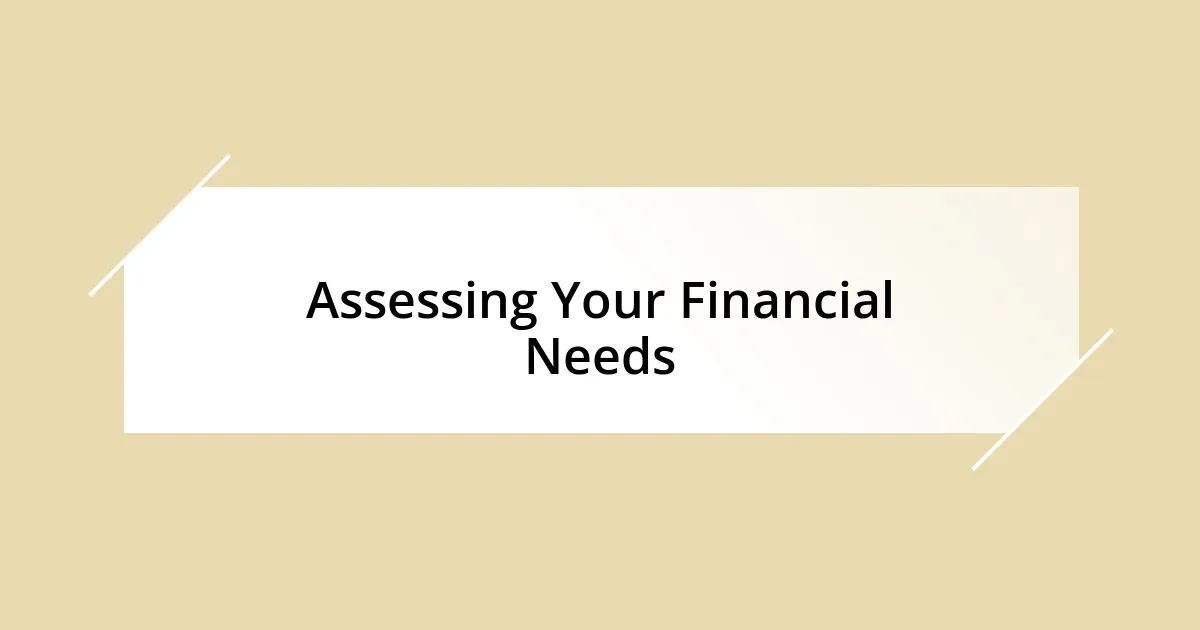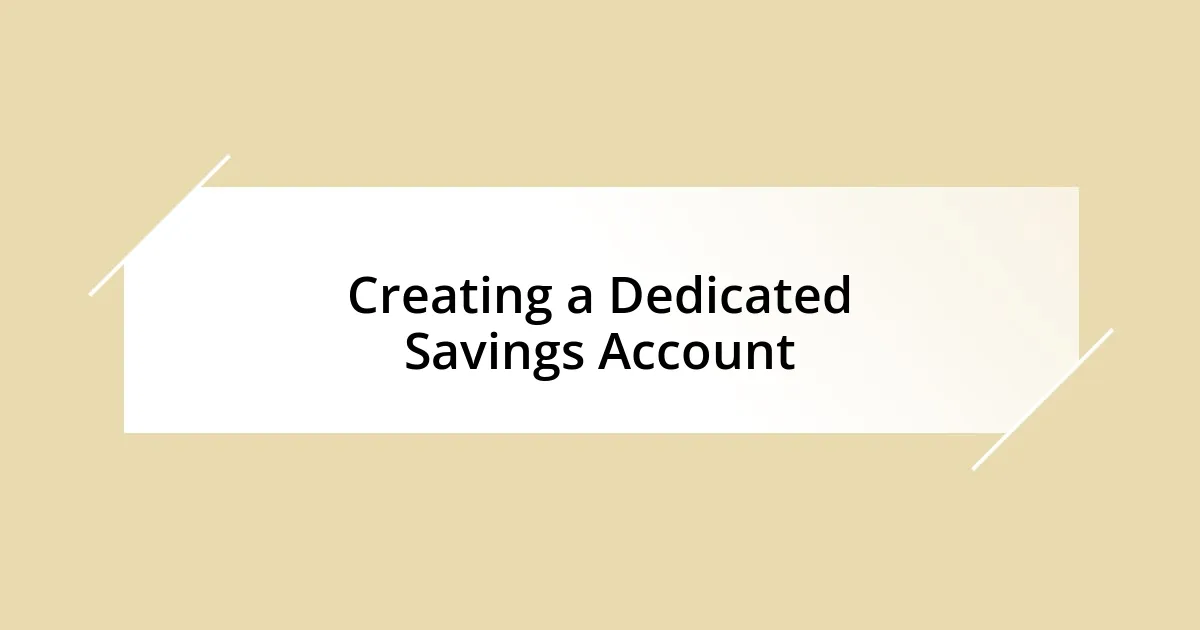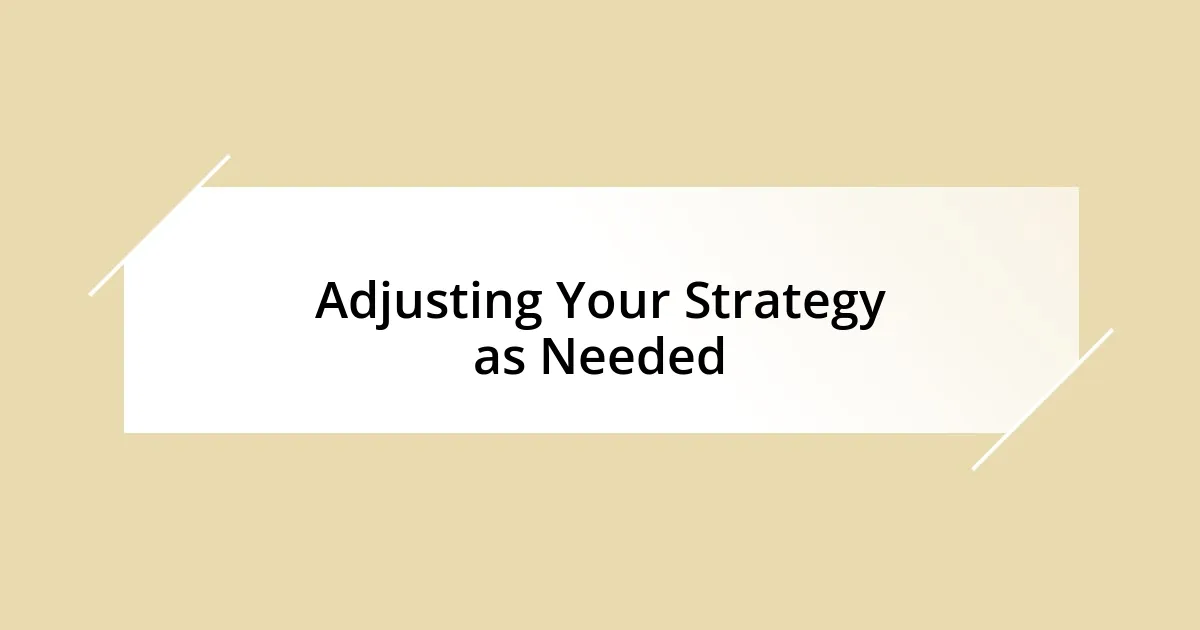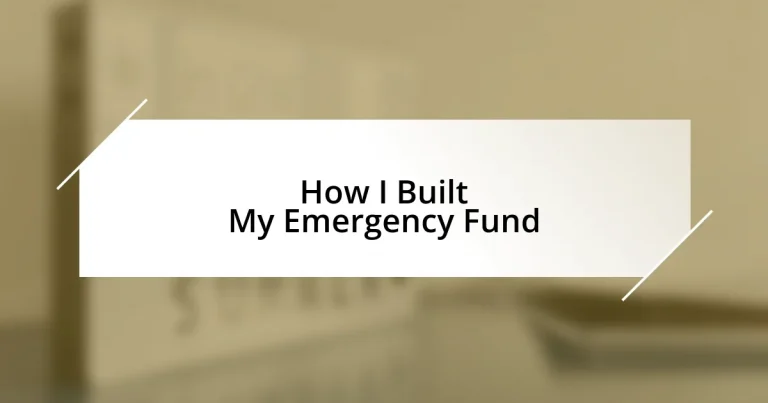Key takeaways:
- Emergency funds act as financial safety nets, providing peace of mind during unexpected expenses.
- Setting realistic and manageable savings goals, such as weekly targets, helps maintain motivation and adaptability.
- Creating a dedicated savings account separates emergency funds from daily expenses, enhancing accountability and ease of saving.
- Regularly tracking progress and adjusting savings strategies as needed fosters resilience and financial control.

Understanding Emergency Funds
An emergency fund can feel like a financial safety net, designed to cushion the blow of unexpected expenses. I remember the first time my car broke down unexpectedly—it hit me like a ton of bricks. Having a dedicated fund meant I could deal with the repairs without anxiety about how to pay the bills.
When I look back, one of the most important lessons I learned was the value of being prepared. Life has a way of throwing surprises our way, doesn’t it? I often think about how my emergency fund saved me during a particularly challenging time when my job was on the line. Knowing I had that financial buffer allowed me to focus on finding a new position rather than panicking about my immediate needs.
Understanding what an emergency fund truly is—typically three to six months’ worth of living expenses—was a game-changer for me. Have you ever considered how quickly costs can add up in an unexpected situation? Just think about medical bills or sudden job loss. I’ve learned that with an emergency fund, I don’t just build savings; I build peace of mind.

Assessing Your Financial Needs
Determining your financial needs is the cornerstone of building an effective emergency fund. I found that taking a close look at my monthly expenses helped me understand exactly how much I needed to save. It’s not just about what I earn but also about evaluating my fixed and variable costs.
Here’s how I broke it down:
- Fixed Expenses: Rent or mortgage, utilities, insurance, and loan payments.
- Variable Expenses: Groceries, dining out, entertainment, and transportation costs.
- Essential Expenses: Healthcare costs, childcare, and any other non-negotiables that arise.
After I gathered all that information, I calculated my total monthly expenses. This was eye-opening! I realized that understanding my costs led me to priorities I didn’t fully appreciate before. For instance, I started questioning how often I indulged in takeout meals versus cooking at home, which ultimately influenced my savings mindset. Each small adjustment added up over time, creating a stronger foundation for my emergency fund.

Setting Realistic Savings Goals
Setting realistic savings goals is essential for building a robust emergency fund. When I first started saving, I aimed high—really high. I thought, “I’ll save $500 a month!” But that quickly turned out to be unrealistic for my lifestyle. Instead, I learned to focus on smaller, manageable amounts, like $100 a month. This way, I felt a sense of accomplishment without feeling overwhelmed. It’s like running a marathon: you wouldn’t start by trying to sprint the whole distance, right? You build up your endurance little by little.
One thing that worked wonders for me was breaking my savings goal down even further. Instead of just thinking about the total amount I wanted, I set weekly goals. For instance, I’d tell myself to save $25 a week. It felt much more attainable that way! Plus, I discovered that when I accomplished these smaller targets, it motivated me to keep going. Have you ever experienced that rush of achievement? It gave me both confidence and clarity in my saving strategy.
As I progressed, I also realized it was important to remain flexible. Life happens, and there were months when unexpected expenses popped up. By adjusting my goals as needed—like reducing my savings for a month or two—I could maintain my overall momentum without derailing my entire plan. This adaptability became a key part of my success.
| Approach | Description |
|---|---|
| High Goal Setting | Aiming for large monthly savings targets can lead to feeling overwhelmed and discouraged. |
| Small, Manageable Goals | Focusing on saving smaller amounts makes the goal feel attainable and boosts motivation. |
| Weekly Targets | Breaking down savings into weekly goals creates a sense of achievement and maintains momentum. |
| Flexibility | Adjusting savings goals helps accommodate life’s unexpected expenses without losing progress. |

Creating a Dedicated Savings Account
Creating a dedicated savings account was a game changer for me. I discovered that using a separate account for my emergency fund helped keep my savings distinct from my daily spending. It’s amazing how just labeling that account as “Emergency Fund” made me feel more accountable and encouraged me to contribute consistently.
At first, I chose an online bank with a higher interest rate because I wanted my money to grow while remaining accessible. Every time I received a paycheck, the first thing I did was transfer a set amount into that dedicated account. I vividly remember the satisfaction I felt watching the balance slowly increase. Have you ever experienced that thrill of seeing your savings grow? It truly fueled my motivation to keep saving!
Over time, I also learned to automate my savings transfers. Setting up automatic transfers cleared the mental clutter and made saving feel effortless. I can’t tell you how liberating it was to know that every month, money was being set aside without me even thinking about it. This simple step transformed my saving strategy, allowing me to focus on other financial goals while still building that crucial safety net.

Automating Your Savings Process
Automating my savings was a real revelation. Once I set up automatic transfers from my checking account to my dedicated emergency fund, it felt like I had unleashed a financial superpower. At first, I was worried I’d miss the money, but honestly, I hardly noticed it disappearing. Isn’t it funny how our minds adapt over time? I remember this sense of relief washing over me when I realized that savings was happening—effortlessly!
I chose to have money transferred right after my paycheck hit my account. This timing was crucial because it turned saving into an automatic habit rather than an afterthought. Just like brushing my teeth, I no longer had to think about it! In fact, I can still recall the moment I added an extra few bucks for a bonus transfer. It was a bit thrilling, like treasuring a secret victory each month. Have you ever felt that rush when you realize you can save just a little more? Trust me, it’s addictive.
Another tip I found useful was setting up multiple savings goals in a single account. Each month, I earmarked part of my auto-savings for different emergencies—like car repairs or medical bills. Watching those categories fill felt rewarding and gave me a sense of purpose. It was as if I was crafting a safety net, one thread at a time. It leaves me wondering: don’t we all want to feel prepared for whatever life throws at us? Automating my savings made me feel just that—prepared and empowered.

Tracking Your Progress Regularly
Tracking my progress regularly was essential to my success in building an emergency fund. I remember sitting down at the end of each month, excited to review my savings. It felt a bit like opening a surprise gift. Not only did it give me an opportunity to celebrate small victories, but it also kept me grounded, reminding me of my financial goals.
One method I found particularly effective was using a simple spreadsheet. Each month, I’d update the balance and take note of how much I’d contributed. The visual of steadily increasing numbers motivated me to keep going. It’s incredible how seeing those numbers grow can evoke such a sense of accomplishment! Have you ever felt that surge of pride when you achieve a goal? I found it fueled my desire to save even more.
Additionally, I combined tracking with reflection. I would ask myself questions like, “What challenges did I face this month?” or “How can I improve my savings strategy?” This process turned my progress tracking into a valuable learning experience. I began to realize that every little setback was just a stepping stone, not a roadblock. By acknowledging challenges, I turned them into opportunities, which ultimately made my emergency fund feel all the more solid.

Adjusting Your Strategy as Needed
Adjusting my strategy as needed became a vital part of my journey towards building a robust emergency fund. I vividly remember a moment when an unexpected car repair bill came my way, throwing my budget into a tailspin. It pushed me to realign my contributions; instead of my usual amount, I decided to temporarily increase my savings to make up for the setback. Have you faced a similar situation where life forced you to rethink your plans? I found that adapting my approach made me feel more in control and resilient.
Sometimes, I’d notice that my savings progress plateaued. During those times, I took a step back and evaluated my overall financial situation. I’d ask myself, “Am I saving enough considering my current expenses?” This self-reflection opened my eyes to the possibility of reallocating funds from less critical areas of my budget. Once, after realizing I wasn’t using my subscription services as much, I cancelled a few and redirected that money straight into my emergency fund. It felt liberating—like cleaning out a cluttered closet!
In moments of doubt, I leaned on my support network for guidance. I recall discussing my savings strategy with a close friend who had successfully built her emergency fund. She encouraged me to be flexible and reminded me how often life demands adjustments. This conversation inspired me to think creatively, ultimately helping me develop a more resilient savings strategy that could adapt to twists and turns. It’s moments like these that remind me: Isn’t it great to have a community that supports your financial journey?














